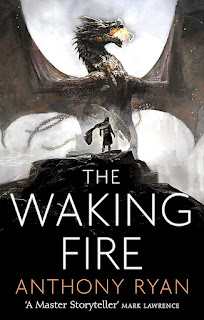The Waking Fire: Book One of Draconis Memoria (The Draconis Memoria) - Anthony Ryan
The world of the Draconis Memoria series is a dark, steampunk style universe. At least that's the initial impression, but things move along rapidly here and inventions come quick and fast. Rather than steam being the force that metaphorically oils the wheels and drives the engines of this society it's another product that is of vital importance - blood. Dragon blood, or 'drakes' as they are called here, but regardless of the nomenclature, you know essentially what you are dealing with. Or so you might think, but as I've said, things have a way of changing quickly in The Waking Fire.
There are several different types of drake - Green, Red, Blue and Black - each with different properties that when properly processed can enhance the abilities of any humans who are able to partake of it. Green enhances the body's abilities, gives extra strength, energy, speed and agility, but it also has powerful medicinal and healing properties. Red is fire and it's primarily the conversion of red energy through thermoplasmic engines, usually only by those with Blood-born abilities, that drive the engines of machinery and some specially equipped ships. Blue blood permits entering a trance-like state that allows mind-connection communication, which is useful as there are no phones or telegrams in this world. Black, well, that's the most powerful of all, but it can be deadly to anyone who is not able to process it.
So essentially, ingestion of drake's blood enhances and gives superhuman powers to a percentage of the population capable of imbibing it. That's not terribly original, but Ryan presents a series of thrilling encounters to show how it can be used in different circumstances according to the need of the situations of three main characters. Lizanne is a secret agent for Executive Initiatives. She's been sent undercover and at great personal risk to find documents and instruments that might hold the clue to unlock an important discovery. Clay, a young man involved in backstreet criminality, has also been co-opted with members of his gang to search for the elusive 'treasure' in the vast jungles of the north. Hilemore, meanwhile, has just signed up as second mate on the Ironship war vessel Viable Opportunity, a ship modified to capitalise on Blood-born engine power.
That's a fair bit of variety that shows several sides of the world and the qualities that drake's blood can enhance. Essentially however all you really have is three familiar genre tales under a fantasy umbrella. Lizanne's is a fairly standard espionage tale - albeit one in using steampunk-like weaponry and technology; Clay's is an Allan Quatermain adventure of lost cities and civilisations in jungles populated by wild savages (the Spoiled) and dangerous animals (drakes); and Hilemore's is a rip-roaring swashbuckling high seas adventure of sea-battles, piracy and sea monsters. Aside from what amounts to little more than a dressed-up version of a quest to fulfil old prophesies (here relating to the writings of the Mad Artisan), what is most disappointing and again somewhat lacking in originality, is that the underlying situation that drives the action in The Waking Fire forward and at a dizzying speed is war.
For all its length, there is in fact very little time spent establishing exactly what the historical situation and source of the conflict is that lies between the Ironship Protectorate and the Corvantine Empire. There are intriguing elements in the nature of the struggles between Republican, Monarchist and Corporate empires, with evolutionary science in opposition to mythological creationist legends, but it's all one-sided and you never quite get a handle on the nature of the schisms and antagonism that drives the opposing forces into what is clearly developing into a full-scale war. With Clay out there in the jungle stirring up tensions, activating and displacing hordes of Spoiled, Reds and Greens, it's going to be a war of huge proportions and the object of their search is clearly going to be vital towards determining its outcome.
It's going to be a war that also calls for a vitally important and inventive response to the rapidly developing and changing situation. Essentially, Anthony Ryan is depicting a world where war is the driver of change and necessity to adapt and survive it is the mother of invention. It all comes very quickly and perhaps too easily, with Lizanne - even though she is from a family of famous inventors - in particular proving capable of progressing the evolution of this society through continuous reinvention in response to the escalating situation. We seem to skip from primitive steampunk fantasy early industrial society to WWI-like killing machines and beyond in leaps and bounds, years of progress distilled down into hours and days. But it isn't just society that is capable of learning and adapting. The Waking Fire is far from dull, constantly moving forward through one battle to the next bigger one, but by the same token it's also fallen into a pattern of repetition and familiarity, and for all it's variety, it's wasn't all that original in the first place.




Comments
Post a Comment